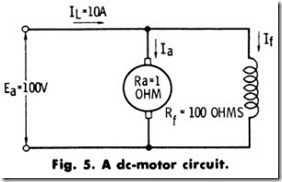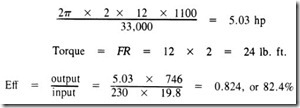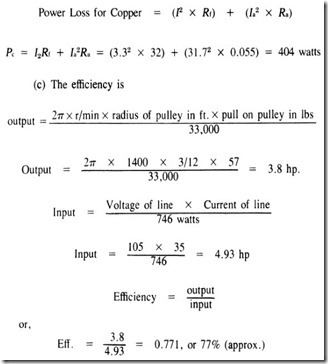Problem-Assume that the de motor shown in Fig. 5 draws a current of 10 amperes from the line with a supply voltage of 100 volts. If the total mechanical loss (friction, windage, etc.) is 90 watts, calculate the
(a) Copper losses in the field.
(b) Armature current.
(c) Copper losses in the armature .
(d) Total loss.
(e) Motor input.
(f) Motor output.
(g) Efficiency.
Solution-From the foregoing data we obtain:
(a) The copper losses in the field are
(b) The armature current is
(c) Copper losses in the armature are
(d) The total loss is
(e) Motor input is
(f) Motor output is equal to
( g) The efficiency is equal to
Problem-A 50-hp, 500-volt shunt motor draws a line current of4.5 amperes at no load. The shunt field resistance is 250 ohms and the armature resistance, exclusive of brushes, is 0.3 ohm. The brush drop is 2 volts. The full-load line current is 84 amperes. What is the horsepower output and efficiency?
Solution-From the data supplied, we obtain:
Full-load armature current
No-load armature current
Stray power loss
Brush loss
The efficiency of the motor
Problem-Calculate the horsepower output, torque, and efficiency of a shunt motor from the following data:
I1 = 19.8 amperes
E1 = 230 volts
Balance reading == 12 lbs. corrected for zero reading Brake arm = 2ft.
Speed = 1100 r/min
Solution-The horsepower output of the motor is:
Problem-A shunt motor with an armature and field resistance of 0.055 and 32 ohms, respectively, is to be tested for its mechanical efficiency by means of a rope brake. When the motor is running at 1400
r/min, the longitudinal pull on the 6-inch-diameter pulley is 57 lbs. Simultaneous readings of the line voltmeter and ammeter are 105 and 35, respectively. Calculate the
(a) Counter emf
(b) Copper losses.
(c) Efficiency.
Solution-From the foregoing data:
La = Current of armature
LL = Current of line
Lf = Current of field
(a) The counter emf is
(b) The copper losses are




